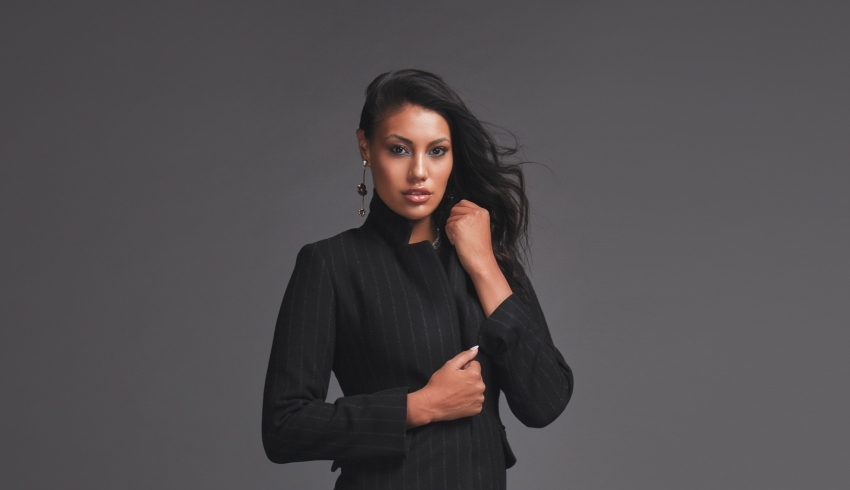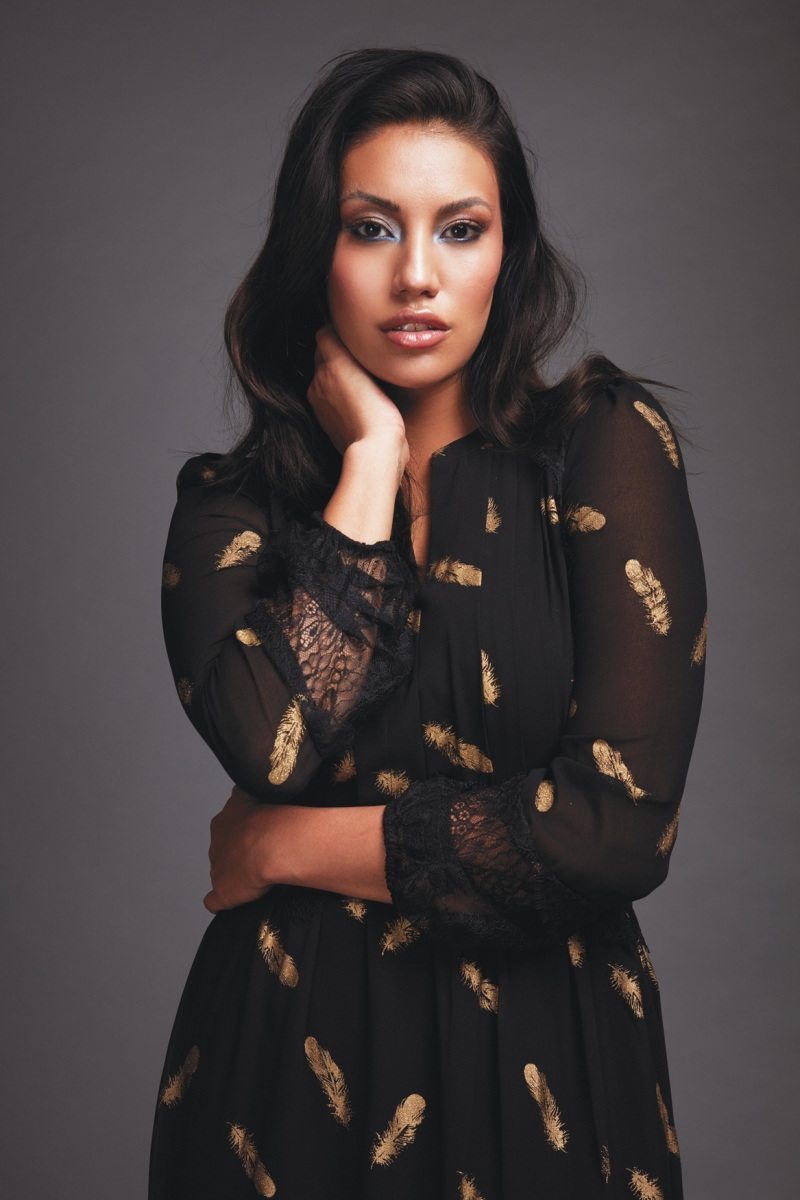
It’s Aboriginal Day – June 21, 2017 – and 28-year-old Indigenous personality Ashley Callingbull stands on a five-foot-high platform, facing a camera in the middle of Edmonton’s Victoria Park. She’s a co-host for the Edmonton segment of Aboriginal Day Live for the Aboriginal Peoples Television Network (APTN). Even though there’s a larger stage behind her with performances from a variety of Indigenous artists, a small crowd gathers (and remains) around the platform to watch Callingbull do her stand-ups in front of the camera. Shouts of support, including a few “I love you, Ashley”s ring out sporadically from the predominantly Indigenous crowd.
“I love you, too,” Callingbull replies to one. The woman who initiated the brief exchange gives a slight yelp in surprise because of Callingbull’s response. The crowd around the platform laughs and cheers at the reaction. Callingbull is a rarity in Canada; an Indigenous celebrity known throughout this country’s mainstream pop culture.
About a half hour later, during a commercial break, Callingbull’s stepfather (who she calls “dad”) and partner on Amazing Race Canada Season 4, Joel Ground, reaches up to the platform and offers her a can of soda and a bag of popcorn. Callingbull grabs both, shoves a handful of popcorn into her mouth, takes a long sip of the soda and sighs. She reluctantly hands the snacks back to Ground because it’s time to go live again.
It’s only a brief glimpse into the off-camera Ashley Callingbull and hints at a secret about Canada’s popular Indigenous beauty queen/actor/model/activist: She loves her junk food. Maybe not so secret – a large percentage of her @ashcallingbull tweets to her 21,000+ Twitter followers and @ashleycallingbull posts to her 187,000+ Instagram followers regale her love of Kentucky Fried Chicken (KFC) and junk food. In fact, she posts about it so frequently that KFC sent her a personalized chicken bucket with her face – instead of the Colonel’s – on it, and Callingbull turned the company’s interest into a sponsorship opportunity.

“During the race, when the crews were interviewing teams in the taxis or at challenges or anything, Ashley always had snacks top of mind,” says Mike Bickerton, the producer and casting director for Amazing Race Canada. Callingbull and her stepfather were the first Indigenous team to participate on the show, finishing in third place after travelling over 25,000 kilometres to over 20 cities. “She could go on and on about how Cheetos and [Hawkins] Cheezies are very, very different,” Bickerton says. (Callingbull likes the crunchier Cheezies.)
Of course, her deep love and knowledge of junk food wasn’t the reason why Bickerton cast Callingbull on the highly-rated reality TV show. It was her actions after she became the first Canadian and the first Indigenous woman to win the Mrs. Universe Pageant in 2015 that first drew his attention to her, as well as the attention of many Canadians. “Maybe this is my preconception, but I just don’t assume that somebody is going to [speak out] with their new-found celebrity,” notes Bickerton. “I assume that people are generally a bit more self-serving than community-serving. She immediately went right into using her voice for some kind of good.”
Following her win, Callingbull was on a media whirlwind. “The first day it was like 30-something interviews in a day, back-to-back. That was while I was flying in the air, landing in Toronto, and then that whole day was absolute craziness,” she remembers. “Once I had the media in the palm of my hand, I thought, ‘This is the perfect time to speak the truth.’ The truth is real. The truth is raw, and it is going to stir the pot.” Canadians listened as she spoke frankly about inadequate housing, a lack of clean water, inequality in proper education and healthcare, missing and murdered Indigenous women, suicide rates for children in foster care and other Indigenous issues. When she accused the then-Harper government of treating Indigenous people as terrorists when they stand up for their rights, APTN, Huffington Post and Montreal Gazette claimed Callingbull played a major role in the 2015 election because of her efforts to get more Indigenous people to vote. Even the New York Times noted that it seemed Callingbull had more influence during the election on Indigenous people than the head of the Assembly of First Nations.

In non-Indigenous Canada, whether she was doing good or not was determined by what side of the political spectrum one’s opinions fell on. But Callingbull didn’t care. She had to speak her truth. And, in a very short period of time, she had become something that she never really had growing up as a kid in Enoch: A positive Indigenous role model. Callingbull’s childhood was marked by poverty, and she alleges she was physically and sexually abused by someone in her life. “We had to pick bottles every day just to eat. I remember we would just be counting how many perogies we could eat for supper, and that was really sad,” she says. “My mom worked really hard to give me the best that she could, but during that time she didn’t know I was living through abuse. It was a really difficult time for me. I was dealing with a lot of insecurities and I hated myself for everything that I’d been through. I was afraid that I was going to go into a life of despair and I thought my life would just crumble beneath me.” In October, she shared her story on Instagram to participate in the #MeToo movement.
Reconnecting to her Cree culture helped her stabilize her emotional ground and helped find the ability to heal. She fled the abuse and moved in with her grandparents, a medicine man and woman in Enoch. Through ceremonies and language, she found pride in Cree self-identification, along with strength and peace within herself. “I learned to let go and I learned to heal through my culture. That’s what made me a stronger, more independent person. It made me proud of who I am, and it made me not hold on to pain anymore.”
She got involved with charities, working for the Lung Association because she had tuberculosis when she was nine, the Canadian Cancer Society when her mother was diagnosed with cancer and the Stollery Children’s Hospital where her six-day-old sister, Ambee, died due to a genetic disorder. Then, reluctantly she admits, she started entering beauty pageants. “It didn’t seem like something that I’d like to do because I’m a girl that’s very down-to-Earth,” Callingbull says. “The Ashley out of the public eye is way more laid-back,” she says. “I never brush my hair or really do my makeup. I always wear sweatpants, hoodies and runners.” A friend’s idea to use the contests as a means of supporting her favourite charities was the tipping point, so she entered the competitive world of pageantry. She made a name for herself locally, winning all the local Enoch events, then became the second runner-up for the 2010 Miss Universe Canada pageant before the big Mrs. Universe win in 2015 put her more into the public eye. Unlike other pageants, Mrs. Universe focuses on what participants have done for their country, rather than just their looks and does not have a, what has been called sexist, swimsuit competition.

Appearing on Amazing Race Canada in 2016 gave her an even more expansive profile. Now, she’s booked solidly through spring 2018, her schedule filled with speeches, workshops, auditions, photo shoots and other appearances, including a national campaign as the face of philanthropic jewellery company, Hillberg and Berk.
“I do a lot of different things, but I’m always trying to focus on working with the youth first,” she says, the day after spending a week at the Learning Lead Hockey Camp in Whitehorse, Yukon. Callingbull is also a spokesperson and model for Nike’s N7 Fund, an organization that provides funding and equipment for Indigenous youth sport programs in North America. “It’s important to me because they’re our future leaders and I try to give back to these kids who are struggling through the same things that I struggled through. When I was growing up I didn’t have much and I didn’t have any real role models to look up to that could encourage me and put me on the right path. I had to work hard on my own to get where I am today. If I can bring a light into someone’s life and give them that positivity, that motivation to move them forward to a good place, I’d love to be that person. I just love working with the youth because it’s also so much fun. I just like to bring a smile to their face in any way that I can.”







